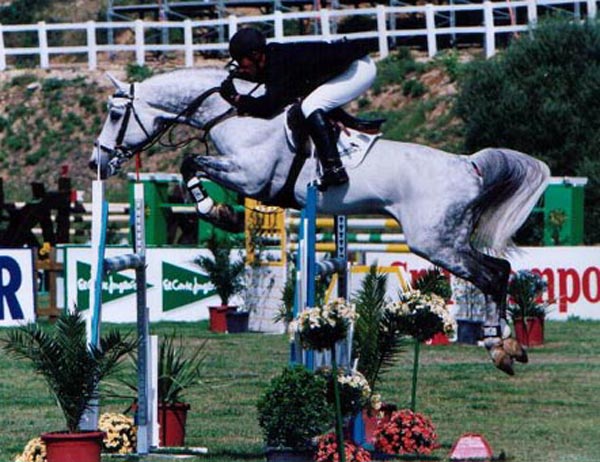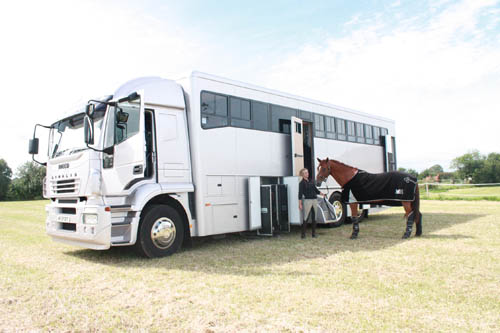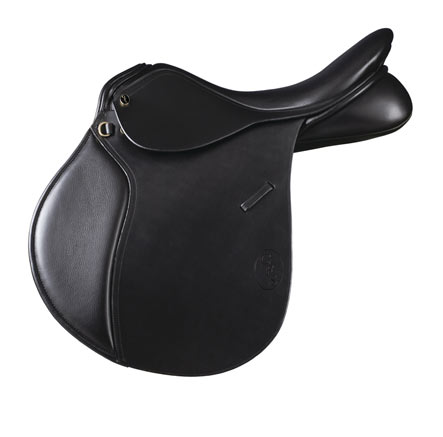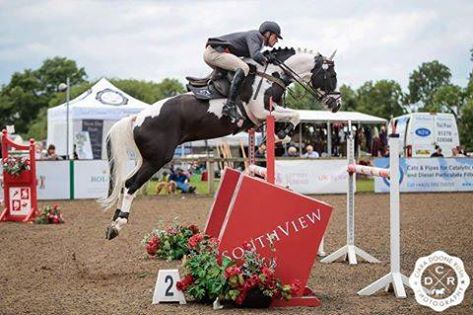Kelso
Kelso (April 4, 1957 – October 16, 1983) was an American thoroughbred race horse considered among the best racehorses of the 20th century. In the list of the top 100 U.S. thoroughbred champions of the 20th Century by The Blood-Horse magazine Kelso ranks 4th, behind only Man o' War (1st), Secretariat (2nd) and Citation (3rd).Kelso's breeding was less than stellar. Born at Claiborne Farm near Paris, Kentucky, he was sired by a well-known racehorse who was an unproven stallion, Your Host. Kelso's dam was the unheralded Maid of Flight (although her sire was Count Fleet and her grandsire was Man o' War. Kelso was her first foal; he was scrawny, runty and hard to handle. He was a maternal grandson of U.S. Triple Crown champion Count Fleet, who is ranked #5 by The Blood-Horse.[1] Before he set foot on a track, owner Allaire du Pont had him gelded in the hopes of calming him down. According to many, it did not work; Kelso was never a well-mannered horse. He was named for Mrs. du Pont's friend Kelso Everett and, like Mr. Everett who went by the nickname of "Kelly", so did the horse.
Trained by Dr. John Lee and racing for Ms. du Pont's nom de course Bohemia Stable, Kelso made his two-year-old debut on September 4, 1959 at Atlantic City Race Course (at that time one of the country's premier tracks). Ridden by John Block, Kelso's first race was an ordinary maiden event (which he won). He was lightly regarded in his second start ten days later, when he finished second. The gelding was the favorite in his third race, which was shortly after his second and in which he again placed second. So ended his freshman season.
The Right Rev. Arthur Raymond McKinstry was known as Kelso's chaplain. In talking to reporters McKinstry said, "On the occasion of President Johnson and Mrs. Johnson's 30th wedding anniversary, the White House reporters asked me if I had any other claim to fame. I thought a little while and then had to confess to them that, among my friends in Wilmington, I am casually spoken of as the private chaplain for the great racehorse, Kelso. Taken aback, one reporter turned and asked me, 'Do you mean to say that you direct heavenly words to God on behalf of a racehorse?' 'I don't have to,' I replied. 'Let's say I just sit there with my fingers crossed and hope a little.'"
Kelso's three-year-old season began after the Triple Crown[1] races of 1960 were run. Dr. John Lee had returned to his veterinary practice, and Kelso's new trainer was Carl Hanford (inducted into the National Museum of Racing and Hall of Fame in 2006), who handled him for the remainder of his career. Willie Shoemaker was his jockey for a short time followed by Eddie Arcaro, who rode him from mid-1960 to November 1961 when he retired as a jockey. In 1962, Ismael Valenzuela became Kelso's principal rider for more than three years.
Kelso's first start as a three-year-old (and first win for Hanford) was at Monmouth Park. Hanford said, "He was an extremely determined horse. If he saw a horse in front, he wanted to get to him. You could take him back or send him to the front. He was an extremely sound horse who was light on his feet with incredible balance. Kelso could wheel on a dime, spinning round in a circle and never letting his feet touch each other." After the Monmouth race, he won eight of his next nine starts: a mile race at Aqueduct Racetrack in a record for a three-year-old at that distance, the Choice Stakes, the Jerome Handicap, the Discovery Handicap, the Lawrence Realization Stakes, the Hawthorne Gold Cup Handicap and the Jockey Club Gold Cup (the latter against older horses). In the Lawrence Realization, he equaled Man O 'War's time of 2:40-4/5 for 1? miles. In 1960, Kelso was voted Three-Year-Old Champion Male and received the Eclipse Award for Horse of the Year.
At age four in 1961, Kelso won seven of nine starts. That year, he was voted Champion Older Horse and again Horse of the Year.
Championships:
1960 Champion 3-yr-old Male, Horse of the Year
1961 Champion Handicap Male, Horse of the Year
1962 Champion Handicap Male, Horse of the Year
1963 Champion Handicap Male, Horse of the Year
1964 Champion Handicap Male, Horse of the Year
Only five-time Horse of the Year in history (as of 2011)
Won five consecutive runnings of the then-two-mile Jockey Club Gold Cup (the most consecutive wins of a major stakes by any horse in history as of 2011)
Won three consecutive Woodward Stakes
Three-time winner of the Whitney Stakes
Two-time winner of the Aqueduct Handicap
Two-time winner of the Suburban Handicap
Won eight of nine races (7 of them stakes) in 1960
Won eight consecutive races (his last six of 1960 and first two of 1961)
Carried 130 pounds on 24 occasions, winning 13, placing in 5, and finishing third once
Won 62% of his starts (39 out of 63 starts)
Finished in the money in 84% of his starts (53 out of 63)
In 1961, Kelso joined Whisk Broom II and Tom Fool as the third horse in history to win the New York Handicap Triple, made up of the Metropolitan Handicap – in which he carried 130 pounds (59 kg), the Suburban Handicap – in which he carried 133 pounds (60 kg) – and the Brooklyn Handicap, in which he carried 136 pounds (62 kg).
Set a new American record for 1½ miles on the turf in the 1964 Washington, D.C. International
Won The Stymie Handicap at age five in 1962, and at age eight in 1965
Long career
Unlike many top racehorses, Kelso's career took a while to warm up. The gelding competed for eight seasons, from 1959 to 1966. As his career reached its zenith so did his popularity, and huge crowds flocked to see him. Kelso competed on fourteen tracks, won in six states, set nine track records (plus two American records), was the all-time leading money-winner with $1,977,896 at his retirement and was beloved by racing fans for his courage and consistency. In a simulated race featuring the top champions of American racing, Kelso beat Man O' War by a half-length.
In 1965 during a workout, Kelso suffered a hairline fracture of the inside sesamoid of his right hind foot. Though he had planned for another year's racing, Hanford retired him at age nine. Kelso left the track as racing's all-time leading money winner with lifetime earnings of $1,977,896. This earnings record held for 14 years, until it was surpassed by Affirmed in 1979. Of Kelso's 63 starts he won 39, placed 12 times and finished third twice. He was out of the money only 10 times.
Accepting his Hall of Fame award in August 2006, Carl Hanford said "I am here today because of one horse and one horse only. Although I've had a few stakes horses before, they didn't compare with Kelso. There is an old saying on the racetrack that 'a good horse is dangerous in anybody's hands.' How true that is. Of all the top trainers in the past that have had this honor, I may be a little bit prejudiced, but I don't think any one of them had their hands on a horse like Kelso".
Retirement
As a gelding, Kelso could not be retired to stud. Instead, he went on to a second career as a hunter and show jumper. In 1967, he was elected to the National Museum of Racing and Hall of Fame.
Kelso died on October 16, 1983. He is buried in the equine cemetery at Allaire du Pont's Woodstock Farm in Chesapeake City, Maryland



GFS Horse Rugs - Horse Rugs Online: Turnout Rugs, Stable Rugs and Blankets Pictures | Stable Construction | Event Horses | Event Horses | Horse Websites



